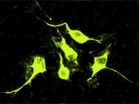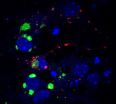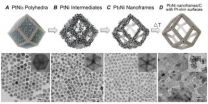Study identifies possible new target for future brain cancer drugs
2014-02-27
(Press-News.org) COLUMBUS, Ohio – A molecule in cells that shuts down the expression of genes might be a promising target for new drugs designed to treat the most frequent and lethal form of brain cancer, according to a new study by researchers at The Ohio State University Comprehensive Cancer Center – Arthur G. James Cancer Hospital and Richard J. Solove Research Institute (OSUCCC – James).
The findings, published in the journal Cancer Research, show that high levels of the enzyme PRMT5 are associated with aggressive growth of the brain cancer glioblastoma multiforme (GBM). The malignancy strikes nearly 14,000 Americans annually. It is a highly invasive form of cancer that is difficult to remove entirely by surgery. Following surgery, chemotherapy and radiation, average survival is still only 15 months, pointing to a critical need for new treatments.
This study shows that inhibiting PRMT5 can significantly improve survival in an animal model of GBM. Blocking the enzyme inhibited the growth, proliferation and migration of GBM cells in laboratory studies, and it increased the number of GBM cells that died by apoptosis.
"Our findings suggest that PRMT5 is a possible prognostic factor and therapeutic target for glioblastoma, and they provide a rationale for developing agents that target PRMT5 in this deadly disease," says co-corresponding author Robert A. Baiocchi, MD, PhD, associate professor of medicine and a hematologist at the OSUCCC – James who is also collaborating on an Ohio State effort to develop a PMRT5 inhibitor.
"Our analyses also helped us identify PRMT5 as a master transcriptional repressor (gene silencer) in this disease, says co-corresponding author Balveen Kaur, PhD, professor of Neurological Surgery at the OSUCCC – James.
"We also learned that PRMT5 inhibition induced the death of glioblastoma cells whether the P53 gene was mutated or not. This has important treatment implications because loss of P53 is associated with a poor prognosis in these patients, so a PRMT5 inhibitor might be particularly important for these patients," says Kaur, who is specializes in glioblastoma research and is chief of Ohio State's Dardinger Laboratory of Neurosciences.
PRMT5 (protein arginine methyltransferase 5) is an enzyme that alters the structure of chromatin to suppress the transcription of genes and the production of proteins. To conduct their study, Kaur, Baiocchi and their colleagues used tumor tissue from patients, cell lines and an animal model. Key findings included:
PRMT5 is selectively over-expressed in glioblastoma and the degree of PRMT5 expression correlates with cell growth and patient survival.
In GBM patients, PRMT5 expression levels in tumor were significantly associated with lower overall survival;
Patients with high PRMT5 tumor expression had shorter overall survival (108 days) compared to patients with medium expression (277 days) and low expression (726 days).
INFORMATION:
This work was supported by grants from NIH/National Institute of Neurological Disorders and Stroke (1R21NS071346-01), The Ohio Cancer Research Associates, V Foundation, 2009 AACR-National Brain Tumor Society Fellowship, in Memory of Bonnie Brooks, and the European Society of Hematology/American Society of Hematology.
Other researchers involved in this study were Fengting Yan, Lapo Alinari, Mark E. Lustberg, Ludmila Katherine Martin, Hector M. Cordero-Nieves, Yeshavanth Banasavadi-Siddegowda, Erica Hlavin Bell, Jeffrey Wojton, Naduparambil K. Jacob, Arnab Chakravarti, Michal O. Nowicki, Xin Wu, Rosa Lapalombella, Jharna Datta, Bo Yu, Kate Gordon, Amy Haseley, John T. Patton, Porsha L. Smith, John Ryu, Xiaoli Zhang, Xiaokui Mo, Guido Marcucci, Gerard Nuovo, Chang-Hyuk Kwon, John C. Byrd, , Chenglong Li, Said Sif and Samson Jacob of Ohio State; E. Antonio Chiocca and Sean Lawler, Harvard University; and Jill Barnholtz-Sloan and Selene Virk of Case Western Reserve University.
The Ohio State University Comprehensive Cancer Center – Arthur G. James Cancer Hospital and Richard J. Solove Research Institute strives to create a cancer-free world by integrating scientific research with excellence in education and patient-centered care, a strategy that leads to better methods of prevention, detection and treatment. Ohio State is one of only 41 National Cancer Institute (NCI)-designated Comprehensive Cancer Centers and one of only four centers funded by the NCI to conduct both phase I and phase II clinical trials. The NCI recently rated Ohio State's cancer program as "exceptional," the highest rating given by NCI survey teams. As the cancer program's 228-bed adult patient-care component, The James is a "Top Hospital" as named by the Leapfrog Group and one of the top cancer hospitals in the nation as ranked by U.S.News & World Report. END
ELSE PRESS RELEASES FROM THIS DATE:
Social workers' roles in patient care expand under affordable care act
2014-02-27
CHESTNUT HILL, Mass. (Feb. 27, 2014) — Social workers will see their roles in patient care expand as hospitals and other providers draw on a range of professionals to meet the demands of the Affordable Care Act, experts told the Boston College Graduate School of Social Work Forum "Health Care Reform: From Policy to Practice."
Former Harvard Pilgrim Health Care CEO Charles D. Baker Jr., the keynote speaker, said social workers bring an expansive view of care options and can play crucial roles, particularly under a "team-based care" approach.
"When I think of social workers, ...
Bison ready for new pastures?
2014-02-27
A new study from the USDA Animal and Plant Health Inspection Services (APHIS) and the Wildlife Conservation Society (WCS) demonstrates that it is possible to qualify bison coming from an infected herd as free of brucellosis using quarantine procedures. These bison can then be used to seed conservation herds in other landscapes without the threat of spreading the disease.
In response to Interagency Bison Management Plan (IBMP) guidelines on federal and state bison management actions, the USDA, APHIS Brucellosis Eradication: Uniform Methods and Rules protocol for the quarantine ...
10,000 years on the Bering land bridge
2014-02-27
SALT LAKE CITY, Feb. 27, 2014 – Genetic and environmental evidence indicates that after the ancestors of Native Americans left Asia, they spent 10,000 years in shrubby lowlands on a broad land bridge that once linked Siberia and Alaska. Archaeological evidence is lacking because it drowned beneath the Bering Sea when sea levels rose.
University of Utah anthropologist Dennis O'Rourke and two colleagues make that argument in the Friday, Feb. 28, issue of the journal Science. They seek to reconcile existing genetic and paleoenvironmental evidence for human habitation on ...
A bird's eye view of cellular RNAs
2014-02-27
BOSTON -- In biology, as in real estate, location matters. Working copies of active genes -- called messenger RNAs or mRNAs -- are positioned strategically throughout living tissues, and their location often helps regulate how cells and tissues grow and develop. But to analyze many mRNAs simultaneously, scientists have had to grind cells to a pulp, which left them no good way to pinpoint where those mRNAs sat within the cell.
Now a team at the Wyss Institute of Biologically Inspired Engineering at Harvard University and Harvard Medical School, in collaboration with ...
Scientists uncover trigger for most common form of intellectual disability and autism
2014-02-27
NEW YORK (February 27, 2014) -- A new study led by Weill Cornell Medical College scientists shows that the most common genetic form of mental retardation and autism occurs because of a mechanism that shuts off the gene associated with the disease. The findings, published today in Science, also show that a drug that blocks this silencing mechanism can prevent fragile X syndrome – suggesting similar therapy is possible for 20 other diseases that range from mental retardation to multisystem failure.
Fragile X syndrome occurs mostly in boys, causing intellectual disability ...
CU-led study says Bering Land Bridge a long-term refuge for early Americans
2014-02-27
A new study led by the University of Colorado Boulder bolsters the theory that the first Americans, who are believed to have come over from northeast Asia during the last ice age, may have been isolated on the Bering Land Bridge for thousands of years before spreading throughout the Americas.
The theory, now known as the "Beringia Standstill," was first proposed in 1997 by two Latin American geneticists and refined in 2007 by a team led by the University of Tartu in Estonia that sampled mitrochondrial DNA from more than 600 Native Americans. The researchers found that ...
Fossils offer new clues into Native American's 'journey' and how they survived the last Ice Age
2014-02-27
Researchers have discovered how Native Americans may have survived the last Ice Age after splitting from their Asian relatives 25,000 years ago.
Academics at Royal Holloway, University of London, and the Universities of Colorado and Utah have analysed fossils which revealed that the ancestors of Native Americans may have set up home in a region between Siberia and Alaska which contained woody plants that they could use to make fires. The discovery breaks new ground as until now no-one had any idea of where the native Americans spent the next 10,000 years before they appeared ...
Researchers reveal the dual role of brain glycogen
2014-02-27
In 2007, in an article published in Nature Neuroscience, scientists at the Institute for Research in Biomedicine (IRB Barcelona) headed by Joan Guinovart, an authority on glycogen metabolism, reported that in Lafora Disease (LD), a rare and fatal neurodegenerative condition that affects adolescents, neurons die as a result of the accumulation of glycogen—chains of glucose. They went on to propose that this accumulation is the root cause of this disease.
The breakthrough of this paper was two-sided: first, the researchers established a possible cause of LD and therefore ...
UCSB study reveals evolution at work
2014-02-27
New research by UC Santa Barbara's Kenneth S. Kosik, Harriman Professor of Neuroscience, reveals some very unique evolutionary innovations in the primate brain.
In a study published online today in the journal Neuron, Kosik and colleagues describe the role of microRNAs — so named because they contain only 22 nucleotides — in a portion of the brain called the outer subventricular zone (OSVZ). These microRNAs belong to a special category of noncoding genes, which prevent the formation of proteins.
"It's microRNAs that provide the wiring diagram, dictating which genes ...
Big step for next-generation fuel cells and electrolyzers
2014-02-27
A big step in the development of next-generation fuel cells and water-alkali electrolyzers has been achieved with the discovery of a new class of bimetallic nanocatalysts that are an order of magnitude higher in activity than the target set by the U.S. Department of Energy (DOE) for 2017. The new catalysts, hollow polyhedral nanoframes of platinum and nickel, feature a three-dimensional catalytic surface activity that makes them significantly more efficient and far less expensive than the best platinum catalysts used in today's fuel cells and alkaline electrolyzers. This ...








